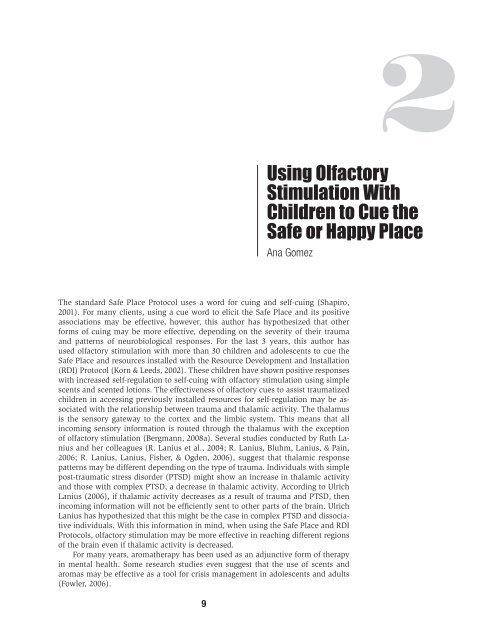(EMDR) Scripted - Springer Publishing
(EMDR) Scripted - Springer Publishing
(EMDR) Scripted - Springer Publishing
You also want an ePaper? Increase the reach of your titles
YUMPU automatically turns print PDFs into web optimized ePapers that Google loves.
2<br />
Using Olfactory<br />
Stimulation With<br />
Children to Cue the<br />
Safe or Happy Place<br />
Ana Gomez<br />
The standard Safe Place Protocol uses a word for cuing and self-cuing (Shapiro,<br />
2001). For many clients, using a cue word to elicit the Safe Place and its positive<br />
associations may be effective, however, this author has hypothesized that other<br />
forms of cuing may be more effective, depending on the severity of their trauma<br />
and patterns of neurobiological responses. For the last 3 years, this author has<br />
used olfactory stimulation with more than 30 children and adolescents to cue the<br />
Safe Place and resources installed with the Resource Development and Installation<br />
(RDI) Protocol (Korn & Leeds, 2002). These children have shown positive responses<br />
with increased self-regulation to self-cuing with olfactory stimulation using simple<br />
scents and scented lotions. The effectiveness of olfactory cues to assist traumatized<br />
children in accessing previously installed resources for self-regulation may be associated<br />
with the relationship between trauma and thalamic activity. The thalamus<br />
is the sensory gateway to the cortex and the limbic system. This means that all<br />
incoming sensory information is routed through the thalamus with the exception<br />
of olfactory stimulation (Bergmann, 2008a). Several studies conducted by Ruth Lanius<br />
and her colleagues (R. Lanius et al., 2004; R. Lanius, Bluhm, Lanius, & Pain,<br />
2006; R. Lanius, Lanius, Fisher, & Ogden, 2006), suggest that thalamic response<br />
patterns may be different depending on the type of trauma. Individuals with simple<br />
post-traumatic stress disorder (PTSD) might show an increase in thalamic activity<br />
and those with complex PTSD, a decrease in thalamic activity. According to Ulrich<br />
Lanius (2006), if thalamic activity decreases as a result of trauma and PTSD, then<br />
incoming information will not be efficiently sent to other parts of the brain. Ulrich<br />
Lanius has hypothesized that this might be the case in complex PTSD and dissociative<br />
individuals. With this information in mind, when using the Safe Place and RDI<br />
Protocols, olfactory stimulation may be more effective in reaching different regions<br />
of the brain even if thalamic activity is decreased.<br />
For many years, aromatherapy has been used as an adjunctive form of therapy<br />
in mental health. Some research studies even suggest that the use of scents and<br />
aromas may be effective as a tool for crisis management in adolescents and adults<br />
(Fowler, 2006).<br />
9

















